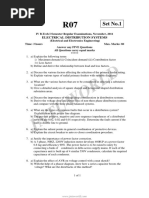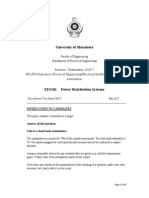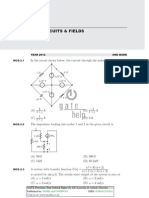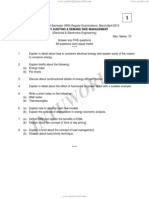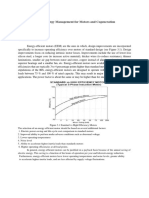Distribution of Electric Power
Uploaded by
sreenivasroyal8Distribution of Electric Power
Uploaded by
sreenivasroyal8www.jntuworld.
com
www.jwjobs.net
1
Code: 9A02701 B.TECH IV Year I Semester (R09) Regular Examinations, November 2012 DISTRIBUTION OF ELECTRIC POWER (Electrical & Electronics Engineering) Time: 3 hours Max. Marks: 70 Answer any FIVE questions All questions carry equal marks ***** 1 (a) A 50 MW hydro generator delivers 320 million KWh during the year. Calculate the plant load factor. (b) Explain the load characteristics of distribution system. 2 (a) Distinguish between primary and secondary distribution systems with suitable examples. (b) A 2-wire DC distributor AB, 600m long as loaded as under: Distance from (mts): 150 300 350 450 loads (Amps): 100 200 250 300. The feeding point A is maintained at 440V and that of B at 430V. If each conductor has a resistance of 0.01 per 100 m, calculate i. The currents supplied from A to B. ii. The power dispatched in the distributor. (a) Classify different types of primary feeders and give their merits and demerits. (b) Derive the condition of load factor for which the voltage drop is maximum. (a) What are the factors to be considered for selecting location of substations? (b) Explain the single bus bar system with sectionalization and what are its merits and demerits. (a) Explain the effect of shunt compensation on distribution system. (b) A 3-phase substation transformer has a name plate rating of 7250KVA and a thermal capability of 120 of the name plate rating. If the connected load is 8816KVA with a 0.85pf lagging p.f., determine the following: (i) The KVAR rating of the shunt capacitor bank required to decrease the KVA load of the transformer to its capability level. (ii) The power factor of the corrected level. Show that power loss due to load currents of the two phase, 3 wire lateral with full capacity neutral is exactly equal to 2.25 times larger than the one in which equivalent three phase lateral is used. Also prove that VD pu, 2 =2.1xVDpu, 3 for the above system. (a) Why the improvement of power factor is very important for both consumers and generating stations? List the various causes of low power factor and explain. (b) A single-phase motor takes a current of 10 amps at a p.f. of 0.707 lagging from a 230V, 50 Hz supply. What value must a shunting capacitor have to raise the p.f. to unity. (a) Explain the salient points in general co-ordination procedure. (b) Explain fuse-fuse coordination. *****
T N
W U
R O
D L
www.jntuworld.com
www.jntuworld.com
www.jwjobs.net
2
Code: 9A02701 B.TECH IV Year I Semester (R09) Regular Examinations, November 2012 DISTRIBUTION OF ELECTRIC POWER (Electrical & Electronics Engineering) Time: 3 hours Max. Marks: 70 Answer any FIVE questions All questions carry equal marks ***** 1 Discuss about different load modeling and their characteristics. 2 (a) Discuss briefly the requirements of a distribution system. (b) A 2-wire DC ring distributor is 300 m long and is fed at 240 V at point A. At point B, 150 m from A, a load of 120 A is taken and at C, 100 m in the opposite direction, a load of 80 A is taken if the resistance per 100 m of single conductor is 0.03, find i. Current in each section of distributor ii. Voltage at points B and C. (a) Explain radial type primary feeder with neat diagram. (b) Assume that feeder has a length of 2 miles and that the new feeder uniform loading has increased to 3 times the old feeder loading. Determine the new maximum length of the feeder with the same percent voltage drop if the new feeder voltage level is increased 34.5 KV from the previous voltage level of 12.47 KV. (a) Explain the main and transfer bus bar system with circuit diagram. (b) What is the difference between single bus bar with and without sectionalization arrangement? (a) Write short notes on any two methods of voltage control. (b) Voltage control and p.f correction are necessary in power systems. Explain. What are the disadvantages of low voltage and low p.f of the system? A single phase line (ABC) of length 2 Km having resistance and reactance (go and return) as 0.06 and 0.1 ohms/Km. A is the feeding point, B is the mid-point of the line taking a load of 100A at 0.9 p.f leads and C is the far end taking a load of 12 A at UPF. The voltage at the C is 230V. Find the voltage at the sending end and the phase angle difference between the voltages of two ends. If (a) Power factors of the loads are with reference to far end voltage. (b) Power factors of the loads are with reference to the voltages at the load points.
T N
W U
R O
D L
(a) How is economical p.f arrived at for a given distribution system with different loads? (b) A 440 V, 50 cycles three phase line delivers 250 KW at 0.7 p.f (lag). It is desire to bring the line p.f to unity by installing shunt capacitors. Calculate the capacitance if they are: i. star connected ii. delta connected. (a) What are the objectives of distribution system protection? (b) What are the advantages and disadvantages of fuses? *****
www.jntuworld.com
www.jntuworld.com
www.jwjobs.net
3
Code: 9A02701 B.TECH IV Year I Semester (R09) Regular Examinations, November 2012 DISTRIBUTION OF ELECTRIC POWER (Electrical & Electronics Engineering) Time: 3 hours Max. Marks: 70 Answer any FIVE questions All questions carry equal marks ***** 1 (a) Give the classification of loads and draw their characteristics. (b) A load of 100 kW is connected at the riverside substation. The 15 min weekly maximum demand is given by 75 kW and the weekly energy consumption is 4200 kWh. Find the demand factor, the 15 min weekly load factor of the substation and its associate loss factor. 2 (a) Write short notes on various systems of D.C distribution. (b) Distinguish between a feeder, distributor and service main in a distribution scheme. (a) Classify different types of primary feeders and give their merits and demerits. (b) Explain basic design practice of secondary distribution system and also discuss about secondary banking. What are the different types of bus-bar arrangements used in sub-station? Illustrate your answer with suitable diagrams? (a) Define: i. Voltage regulation ii. Voltage drop iii. Nominal voltage iv. Rated voltage v. Utilization voltage vi. Maximum voltage vii. Minimum voltage (b) Describe different types of equipment for voltage control with neat diagrams. Derive the equation for voltage drop of square shaped service area of substation where the service area is provided with balanced load and lumped at different locations of laterals. A 3-phase transformer rated 7000 KVA and has a over load capability of 125 of the rating. If the connected load is 11150KVA with a 0.8 pf(lag), determine the following: (a) The KVAR rating of shunt capacitor bank required to decrease the KVA load of the transformer to its capability level. (b) The p.f. of the corrected level. (c) The KVAR rating of the shunt capacitor bank required to correct the load p.f to unity. (a) Explain fuse-circuit breaker coordination. (b) Explain recloser-circuit breaker coordination. *****
T N
W U
R O
D L
www.jntuworld.com
www.jntuworld.com
www.jwjobs.net
4
Code: 9A02701 B.TECH IV Year I Semester (R09) Regular Examinations, November 2012 DISTRIBUTION OF ELECTRIC POWER (Electrical & Electronics Engineering) Time: 3 hours Max. Marks: 70 Answer any FIVE questions All questions carry equal marks ***** 1 (a) Define coincidence factor and contribution factor. (b) Obtain the relation between the load factor and loss factor. 2 (a) Discuss the relative merits and demerits of underground and over head systems. (b) An 800m distributor fed from both ends A and B is loaded uniformly at the rate of 1.2 A/m run, the resistance of each conductor being 0.05 per/km. Determine the minimum voltage and the point where it occurs if feeding points A and B are maintained at 255 V and 250 V respectively. Find also the current supplied from feeding point A and B. Derive the total area served by four feeders is 0.667 times the total area served by six feeders if they are thermally loaded. (a) Explain the classification of substations according to design. (b) What are the advantages and disadvantages of outdoor substation as compared to indoor substation? (a) How is economical p.f arrived at for a given distribution system with different loads? (b) Discuss the effect of series capacitors on voltage control. (a) What are the different types of manual methods used for the solution of radial networks? Explain in detail. (b) Derive the equation for load p.f for which the voltage drop is maximum. (a) Explain the disadvantages of low power factor. (b) A single-phase motor connected to a 240V, 50 Hz supply takes 20 A at p.f. of 0.75 lag. A capacitor is shunted across the motor terminals to improve the p.f to 0.9 lag. Determine the capacitance of the capacitor to be used. (a) What is coordination? What is a protective device? (b) Explain general coordination procedure. *****
T N
W U
R O
D L
www.jntuworld.com
You might also like
- rr410207 Electrical Distribution SystemsNo ratings yetrr410207 Electrical Distribution Systems8 pages
- Rr410207 Electrical Distribution SystemsNo ratings yetRr410207 Electrical Distribution Systems8 pages
- 9A02701 Distribution of Electric Power PDFNo ratings yet9A02701 Distribution of Electric Power PDF1 page
- Unit - I: Electrical Distribution SystemsNo ratings yetUnit - I: Electrical Distribution Systems21 pages
- Code No.: EE134/13EE432A IV B.Tech. II Sem. (RA15/RA13) Regular Examinations, March/April - 2019 Electrical Distribution SystemsNo ratings yetCode No.: EE134/13EE432A IV B.Tech. II Sem. (RA15/RA13) Regular Examinations, March/April - 2019 Electrical Distribution Systems1 page
- CONCEPTS-OF-POWER-SYSTEM-ENGINEERING-JAN-2024No ratings yetCONCEPTS-OF-POWER-SYSTEM-ENGINEERING-JAN-20248 pages
- Calculation of Power Loss and Voltage Regulation For Different Static LoadsNo ratings yetCalculation of Power Loss and Voltage Regulation For Different Static Loads14 pages
- 2022 - EE5102 - Distribution Systems-FinalNo ratings yet2022 - EE5102 - Distribution Systems-Final4 pages
- WWW - Manaresults.Co - In: 2. Draw A Block Diagram in Flow Chart Form For A Typical Distribution System PlanningNo ratings yetWWW - Manaresults.Co - In: 2. Draw A Block Diagram in Flow Chart Form For A Typical Distribution System Planning1 page
- Power System Final Exam2016 - 3yearanswerNo ratings yetPower System Final Exam2016 - 3yearanswer11 pages
- Power System Transient Analysis: Theory and Practice using Simulation Programs (ATP-EMTP)From EverandPower System Transient Analysis: Theory and Practice using Simulation Programs (ATP-EMTP)No ratings yet
- r05410210 Electrical Distribution SystemsNo ratings yetr05410210 Electrical Distribution Systems7 pages
- Narayana Engineering College::Nellore: Department of Electrical & Electronics EngineeringNo ratings yetNarayana Engineering College::Nellore: Department of Electrical & Electronics Engineering7 pages
- Bvraju Institute of Technology, Narsapur: Code No: A34B3 R18No ratings yetBvraju Institute of Technology, Narsapur: Code No: A34B3 R183 pages
- Sy Ee Sem Iv Ept 22419 QP Model AnswersNo ratings yetSy Ee Sem Iv Ept 22419 QP Model Answers62 pages
- VSC-FACTS-HVDC: Analysis, Modelling and Simulation in Power GridsFrom EverandVSC-FACTS-HVDC: Analysis, Modelling and Simulation in Power GridsNo ratings yet
- ST Thomas College of Engineering and Technology: KozhuvalloorNo ratings yetST Thomas College of Engineering and Technology: Kozhuvalloor2 pages
- Elective III Electrical Distribution SystemNo ratings yetElective III Electrical Distribution System4 pages
- Tutorial: Subject Code: 2180903 Subject Name: Power System Planning and Design Transmission Lines DesignNo ratings yetTutorial: Subject Code: 2180903 Subject Name: Power System Planning and Design Transmission Lines Design5 pages
- Handbook of Power Systems Engineering with Power Electronics ApplicationsFrom EverandHandbook of Power Systems Engineering with Power Electronics ApplicationsNo ratings yet
- Advanced Control of AC / DC Power Networks: System of Systems Approach Based on Spatio-temporal ScalesFrom EverandAdvanced Control of AC / DC Power Networks: System of Systems Approach Based on Spatio-temporal ScalesNo ratings yet
- A Smart Card Based Prepaid Electricity SystemNo ratings yetA Smart Card Based Prepaid Electricity System4 pages
- Tricks To Remember Currencies of Some CountriesNo ratings yetTricks To Remember Currencies of Some Countries3 pages
- GATE 2014 Answer Keys For EE Electrical EngineeringNo ratings yetGATE 2014 Answer Keys For EE Electrical Engineering1 page
- Fuzzy Logic Controller Based Three-Phase Shunt Active Power Filter For Compensating Harmonics and Reactive Power Under Unbalanced Mains VoltagesNo ratings yetFuzzy Logic Controller Based Three-Phase Shunt Active Power Filter For Compensating Harmonics and Reactive Power Under Unbalanced Mains Voltages11 pages
- UNIT II - Energy Management and AuditingNo ratings yetUNIT II - Energy Management and Auditing35 pages
- Electrical and Chemical Diagnostics of Transformer Insulation Abstrac1No ratings yetElectrical and Chemical Diagnostics of Transformer Insulation Abstrac136 pages
- Power Electronics XMV66FPM001AI XMV Comm ChecklistNo ratings yetPower Electronics XMV66FPM001AI XMV Comm Checklist15 pages
- LN004 - PWM DRIVER For ASYMMETRIC MOTORS (V5.1) PDFNo ratings yetLN004 - PWM DRIVER For ASYMMETRIC MOTORS (V5.1) PDF40 pages
- 03 Rectifier THYTROTRONIC With Thysat Controller100% (1)03 Rectifier THYTROTRONIC With Thysat Controller57 pages
- Guideform Specification REV615 758528 ENbNo ratings yetGuideform Specification REV615 758528 ENb4 pages
- Electrical Installation Work 6th Edition Brian Scaddan Ieng All Chapter Instant Download100% (3)Electrical Installation Work 6th Edition Brian Scaddan Ieng All Chapter Instant Download84 pages
- Code No.: EE134/13EE432A IV B.Tech. II Sem. (RA15/RA13) Regular Examinations, March/April - 2019 Electrical Distribution SystemsCode No.: EE134/13EE432A IV B.Tech. II Sem. (RA15/RA13) Regular Examinations, March/April - 2019 Electrical Distribution Systems
- Calculation of Power Loss and Voltage Regulation For Different Static LoadsCalculation of Power Loss and Voltage Regulation For Different Static Loads
- WWW - Manaresults.Co - In: 2. Draw A Block Diagram in Flow Chart Form For A Typical Distribution System PlanningWWW - Manaresults.Co - In: 2. Draw A Block Diagram in Flow Chart Form For A Typical Distribution System Planning
- Power System Transient Analysis: Theory and Practice using Simulation Programs (ATP-EMTP)From EverandPower System Transient Analysis: Theory and Practice using Simulation Programs (ATP-EMTP)
- Narayana Engineering College::Nellore: Department of Electrical & Electronics EngineeringNarayana Engineering College::Nellore: Department of Electrical & Electronics Engineering
- Bvraju Institute of Technology, Narsapur: Code No: A34B3 R18Bvraju Institute of Technology, Narsapur: Code No: A34B3 R18
- VSC-FACTS-HVDC: Analysis, Modelling and Simulation in Power GridsFrom EverandVSC-FACTS-HVDC: Analysis, Modelling and Simulation in Power Grids
- ST Thomas College of Engineering and Technology: KozhuvalloorST Thomas College of Engineering and Technology: Kozhuvalloor
- Tutorial: Subject Code: 2180903 Subject Name: Power System Planning and Design Transmission Lines DesignTutorial: Subject Code: 2180903 Subject Name: Power System Planning and Design Transmission Lines Design
- Handbook of Power Systems Engineering with Power Electronics ApplicationsFrom EverandHandbook of Power Systems Engineering with Power Electronics Applications
- Advanced Control of AC / DC Power Networks: System of Systems Approach Based on Spatio-temporal ScalesFrom EverandAdvanced Control of AC / DC Power Networks: System of Systems Approach Based on Spatio-temporal Scales
- GATE 2014 Answer Keys For EE Electrical EngineeringGATE 2014 Answer Keys For EE Electrical Engineering
- Fuzzy Logic Controller Based Three-Phase Shunt Active Power Filter For Compensating Harmonics and Reactive Power Under Unbalanced Mains VoltagesFuzzy Logic Controller Based Three-Phase Shunt Active Power Filter For Compensating Harmonics and Reactive Power Under Unbalanced Mains Voltages
- Electrical and Chemical Diagnostics of Transformer Insulation Abstrac1Electrical and Chemical Diagnostics of Transformer Insulation Abstrac1
- Power Electronics XMV66FPM001AI XMV Comm ChecklistPower Electronics XMV66FPM001AI XMV Comm Checklist
- LN004 - PWM DRIVER For ASYMMETRIC MOTORS (V5.1) PDFLN004 - PWM DRIVER For ASYMMETRIC MOTORS (V5.1) PDF
- Electrical Installation Work 6th Edition Brian Scaddan Ieng All Chapter Instant DownloadElectrical Installation Work 6th Edition Brian Scaddan Ieng All Chapter Instant Download

